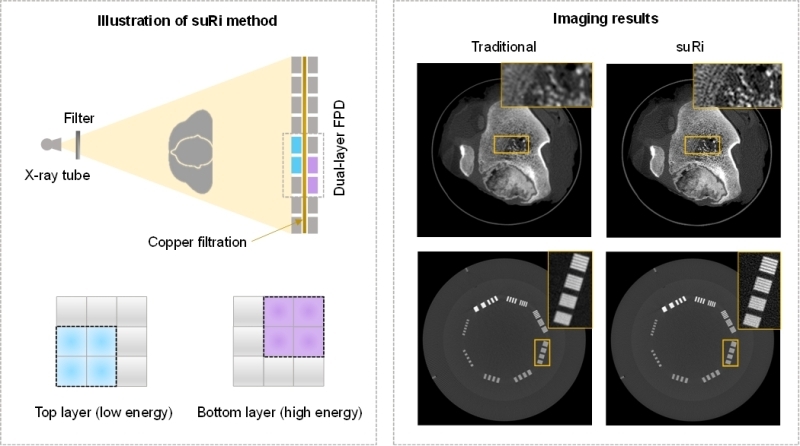Researchers Propose Novel Data Acquisition Method for High Resolution "Spatial-Temporal-Spectral" CBCT Imaging
Date:12-10-2023 | 【Print】 【close】
Over the past two decades, X-ray flat-panel detector (FPD) has been widely used in medical imaging applications. For the three- and four-dimensional cone-beam computed tomography (CBCT) imaging, FPD is also critical among applications such as oral imaging, image-guided radiation therapy and interventional therapy.
However, the dilemma between the pixel-size-defined high spatial resolution and the pixel-number-confined slow data acquisition speed in FPD impedes its further development in advanced CBCT imaging tasks, which require both high spatial and high temporal resolution simultaneously. Besides, the current FPD is also difficult in performing dual-energy CBCT imaging to generate quantitative material-specific images.
Recently, a research group led by Prof. GE Yongshuai from the Shenzhen Institute of Advanced Technology of the Chinese Academy of Sciences has proposed an innovative super resolution dual-energy CBCT (DE-CBCT) imaging method, named as suRi, based on the dual-layer FPD.
The study was published in IEEE Transactions on Medical Imaging on Sep. 27.
In suRi, sub-pixel (half pixel in this study) shifted binning is utilized between the two detector layers to double the spatial sampling rate of the dual-layer FPD during signal acquisition. By doing so, high spatial resolution CBCT imaging can be achieved while at high signal readout speed (large detector binning rate). In addition, a penalized likelihood material decomposition algorithm is developed to directly reconstruct the high resolution material bases from the obtained dual-energy CBCT projections.
Experimental results demonstrate that, at the same signal readout speed (detector binning level), the proposed suRi method can improve the image spatial resolution by over 23% compared with the conventional dual-layer FPD based DE-CBCT imaging. Moreover, accurate basis images with high spatial resolution can be directly reconstructed from such dual-energy projections acquired by suRi.
"We believe this developed suRi method would greatly enhance the imaging performance of the DL-FPD based dual-energy CBCT systems in future," said Prof. GE.

Illustration of the proposed suRi method and the imaging results. (Image by Prof. GE’s group)
Media Contact:
ZHANG Xiaomin
Email:xm.zhang@siat.ac.cn